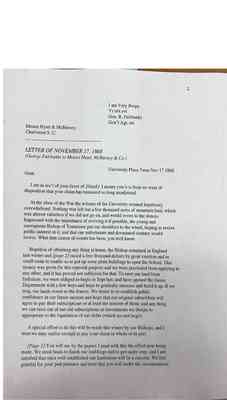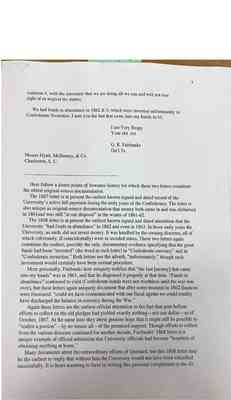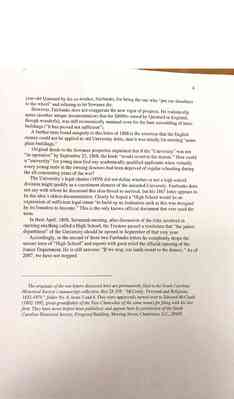Pages
1
Two Hitherto Unpublished Fairbanks Letters: October 17, 1867 and November 17, 1868
In March, 2007, there were quite incidentally unearthed in Charleston's "fireproof Building" two George Fairbanks letters previously unknown to Swewanee historians. Their obscure location makes it very unlikely they had been studied by anyone for well over a century. The letters by no means rewrite history for Sewanee, now celebrating its documentation for several bits of incidental trivia. As of April, copies of the two letters have been placed in the Sewanee Archives, along with a lengthier analysis of their historical significance. Meantime the Keystone publishes here for its readers the following transcriptions of the texts and the minimal list of twelve "earliest documentation" claims that can be made for them.
LETTER OF OCTOBER 17, 1867 (George Fairbanks writes to Messrs Hyatt & McBurney, Charleston)
University Place Tenn Oct 17 1867
Gent. I am in receipt of your favour in reference to balance of afd[amount brought forward?] due you from University of the South from 1860.
The accruing funds of the University were unfortunately invested in Confederate currency and securities, and at the close of the war we found our buildings entirely destroyed, our subscribers ruined and so greatly impoverished that we have as yet not rec'd a dollar from them.
Anxious if possible to have the great scheme [page 2] go on, a few of its friends have endeavored to resuscitate it and have begged some small amount of funds to commence operations again and propose as soon as we can to begin by establishing a High School.
We hope to reinstate in time the whole enterprise and look forward to the time when the country shall have in a measure recovered from its terrible prostration and when its aid may again be involved to build up an Institution such as this was designed by its founders to become. We hope also that many of our subscribers may regain their positionsand means that we will relise a portion of our [page 3] subscriptions. We must therefore beg our creditors indulgence for the present and will, as early as we can realise any of our assets, pay off all we can of our indebtedness. The last money at our disposal (in winter of 1861) I devoted to your debt, and could we have communicated with our fiscal agents we could readily have discharged the balance in currency during the War.
2
I am Very Respy Yr obt svt Geo. R. Fairbanks Gen'l Agt, etc
Messrs Hyatt & McBurney Charleston S.C.
LETTER OF NOVEMBER 17, 1868 (George Fairbanks to Messrs Hyatt, McBurney & Co.)
University Place Tenn Nov 17 1868
Gent. I am in rec't of your favor of [blank]. I assure you it is from no want of disposition that your claim has remained so long unadjusted.
At the close of the War the scheme of the University seemed hopelessly overwhelmed. Nothing was left but a few tousand acres of mountain land, which was almost valueless if we did not go on, and would revert to the donors. Impressed with the importance of reviving it if possible, the young and courageous Bishop of Tennessee put our shoulders to the wheel, hoping to revive public interest in it, and that our unfortunate and devastated country would revive. What that course of events has been, you well know.
Hopeless of obtaining any thing at home, the Bishop remained in England last winter and [page 2] raised a few thousand dollars by great exertion and in small sums to enable us to put up some plain buildings to open the School. This money was given for this especial purpose and we were precluded from applying to any other, and it has proved not sufficient for that. To save our land from forfeiture, we were obliged to begin in Sept last, and have opened the Junior Department with a few boys and hope to gradually increase and build it up. If we stop, our lands revert to the donors. We desire to re-establish public condifence in our future success and hope that our original subscribers will agree to pay their subscriptions or at least the interest of them; and any thing we can raise out of our old subscriptions or investments we design to appropriate to the liquidation of our debts (which are not large).
A special effort to do this will be made this winter by our Bishops, and I trust we may realise enough to pay your claim in whole or in part.
[Page 3] You will see by the papers I send with this effort now being made. We need funds to finish our buildings and to get under way, and I am satisfied that once well-established our Institution will be success. We feel grateful for your past patience and trust that you will under the circumstances
3
continue it, with the assurance that we are doing all we can and will not lose sight of or neglect the matter.
We had funds in abundance in 1862 & 3, which were invested unfortunately in Confederate Securities. i sent you the last that came into my hands in 61.
I am Very Respy Your obt svt
G.R. Fairbanks Gn'l Tr. Messrs Hyatt, McBurney, & Co Charleston, S.C.
Here follow a dozen points of Sewanee history for which these two letters constitute the oldest original-source documentation. The 1867 letter is a present the earliest known signed and dated record of the University's active bill payment during the early years of the Confederacy. The letter is also unique as original-source documentation that money both came in and was disturbed in 1861 and was still "at our disposal" in the winter of 1861-62. The 1868 letter is at present the earliest known signed and dated attestation that the University 'had funds in abundance" in 1862 and even in 1863. In those early years the University, as such, did not invest money. It was handled by the owning dioceses, all of which (obviously, if coincidentally) were in seceded states. These two letters again constitute the earliest, possibly the only, documentary evidence specifying that the great funds had been "invested" (the word in each letter) in "Confederate currency" and in "Confederate securities." Both letters use the adverb, "unfortunately," though such investment would certainly have been normal procedure. More personally, Fairbanks here uniquely testifies that "the last [money] that came into my hands" was in 1861, and that he dispensed it properly at that time. "Funds in abundance" continued to exist (Confederate bonds were not worthless until the war was over), but these letters again uniquely document that after some moment in 1862 finances were frusterated: "could we have communicated with our fiscal agents we could readily have discharged the balance in currency during the War." Again these letters are the earliest official attestation to the fact that post-bellum efforts to collect on the old pledges had yielded exactly nothing- not one dollar- as of October, 1867. At the same time they attest genuine hope that it might still be possible to "realise a portion"- by no means all- of the promised support. Though efforts to collect from various dioceses continued for another decade, Fairbanks' 1868 letter is a unique example of official admission that University officials had become "hopeless of obtaining anything at home." Many documents attest the extraordinary efforts of Quintard, but this 1868 letter may be the earliest to imply that without him the University would not have been rekindled successfully. It is heart-warming to have in writing this personal complaint to the 43-
4
year-old Quintard by his co-worker, Fairbanks, for being the one who "put our shoulders to the wheel" and refusing to let Sewanee die. However, Fairbanks does not exaggerate the new vigor of progress. he realistically notes (another unique documentation) that the $8000+ raised by Quintard in England, though wonderful, was still economically minimal even for the bare assembling of basic buildings ("it has proved not sufficient"). A further item found uniquely in this letter of 1868 is the assertion that the English money could not be applied to old University debts, that it was strictly for erecting "some plain buildings." Originial deeds to the Sewanee properties stipulated that if the "University" was not "in operation" by September 23, 1868, the lands "would revert to the donors." How could a "university" for young men find any academically qualified applicants when virtually every young male in the owning dioceses had been deprived of regular schooling during the all-consuming years of the war? The University's legal charter (1859) did not define whether or not a high-school division might qualify as a constituent element of the intended University. Fairbanks does not say with whom he discussed this slim thread to survival, but his 1867 letter appears to be the idea's oldest documentation. Clearly he hoped a "High School would be an expression of sufficient legal intent "to build up an Instituiton such as this was designed by its founders to become." This is the only known official document that ever used the team. In their April, 1868, Savannah meetng, after discussion of the risks involved in opening anything called a High School, the Trustees passed a resolution that "the junior department" of the University should be opened in September of that very year. Accordingly, in the second of these two Fairbanks letters he completely drops the unsure term of "High School" and reports with great relief the official opening of the Junior Department. He is still nervous: "If we stop, our lands revert to the donors." As of 2007, we have not stopped.
The originals of the two letters discussed here are permanently filed in the South Carolina Historical Society's manuscript collection, Box 28-338: "McCrady: Personal and Religious, 1832- 1879, "folder No. 8, items 3 and 4. They were apparently turned over to Edward McCrady (1802-1892, great-grandfather of the Vice-Chanellor of the same name) for filing with his law firm. They have never before been published, and appear here by permission of the South Carolina Historical Society, Fireproof Building, Meeting Street, Charleston, SC., 29401.



